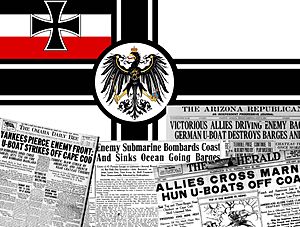Attack on Orleans facts for kids
Quick facts for kids Attack on Orleans |
|||||||
|---|---|---|---|---|---|---|---|
| Part of the U-boat campaign of World War I | |||||||
 Imperial German Ensign and US media coverage of the Attack on Orleans |
|||||||
|
|||||||
| Belligerents | |||||||
| Commanders and leaders | |||||||
| unknown | |||||||
| Strength | |||||||
| Sea: Tugboat Perth Amboy Schooner Lansford 3 barges Air: 9 Curtiss HS seaplanes |
Submarine U-156 | ||||||
| Casualties and losses | |||||||
| Perth Amboy damaged Lansford and 3 barges sunk no casualties |
none | ||||||
The Attack on Orleans was a surprising event during World War I. On July 21, 1918, a German submarine fired its guns near Orleans, Massachusetts. This town is on the eastern coast of the Cape Cod peninsula in the United States. The submarine was aiming at a small group of ships. Some of its shells missed and landed on the nearby land. This made it seem like the town itself was under attack. This was the only time enemy fire reached the mainland United States during World War I.
What Happened at Orleans?
On the morning of July 21, 1918, a German submarine named U-156 was in the area. It was commanded by Captain Richard Feldt. The submarine might have been trying to cut an important underwater communication cable. This cable ran from Orleans all the way to France.
While there, Captain Feldt spotted a tugboat called Perth Amboy. This tugboat was pulling three large barges. A three-masted schooner named Lansford was also with them. The U-156 began to fire its two deck guns at these ships.
The Perth Amboy was badly damaged by the shells. The schooner Lansford and all three barges were sunk. Luckily, no one was hurt or killed in this attack.
Planes Join the Fight
Two flying boats from a nearby air station tried to help. These planes were Curtiss HS-2L models. They dropped bombs near the U-156. However, the bombs did not explode. This was likely due to technical problems or because the airmen were new to arming them.
The U-156 then aimed its guns at the planes. It fired, but missed them. Some of the shells landed harmlessly on a deserted marsh and on Nauset Beach. This is why Orleans is known as the only place in the United States to receive enemy fire during World War I. But the shells were not aimed at the town itself. There were no important targets on land.
Rescue at Sea
A nearby United States Coast Guard station quickly responded. They launched a small boat into the water. Despite the ongoing shellfire, they rowed out to the damaged ships. They rescued 32 sailors who were stuck on the tugboat and barges.
After firing 147 shells, the U-156 went underwater. This happened around 11:30 in the morning. The attack had lasted for about an hour.
A sign on the beach today remembers this event. It says that three miles offshore, a German submarine attacked ships. It also mentions that shells hit the beach. This sign highlights that it was the only time the U.S. coast was shelled by an enemy during World War I.
What Happened Next?
The U-156 got away after the attack. It headed north and attacked other ships belonging to the Allied forces.
A few shells and craters were found on the shore in Orleans. They were also found in the nearby marsh. Newspapers at the time called the event the "Battle of Orleans." Some even offered a reward to find any secret submarine supply bases.
The attack on Orleans was the only time the Central Powers attacked the mainland United States during World War I. It was also the first time the United States had been shelled by an outside power since 1846.


